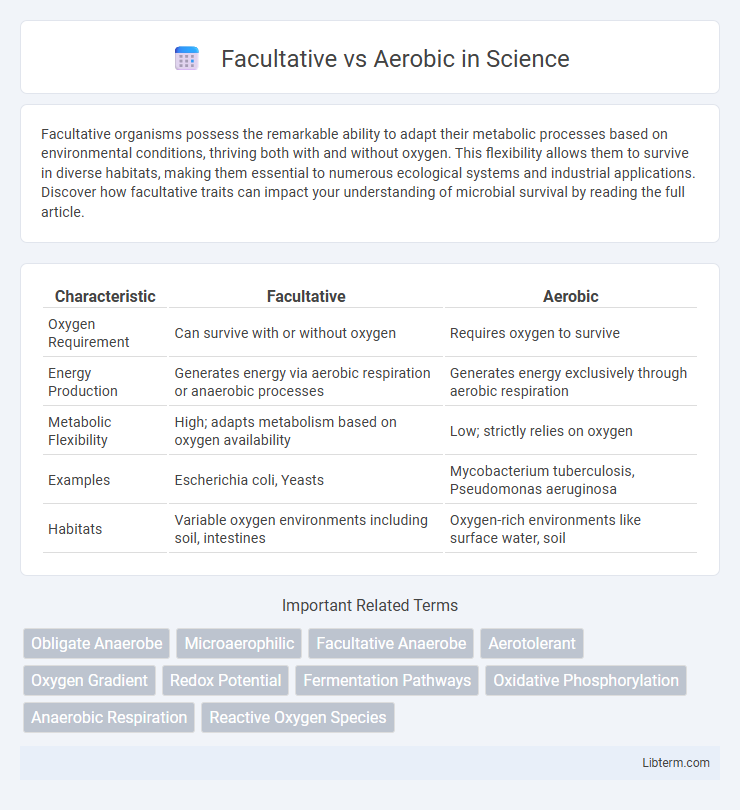Facultative organisms possess the remarkable ability to adapt their metabolic processes based on environmental conditions, thriving both with and without oxygen. This flexibility allows them to survive in diverse habitats, making them essential to numerous ecological systems and industrial applications. Discover how facultative traits can impact your understanding of microbial survival by reading the full article.
Table of Comparison
| Characteristic | Facultative | Aerobic |
|---|---|---|
| Oxygen Requirement | Can survive with or without oxygen | Requires oxygen to survive |
| Energy Production | Generates energy via aerobic respiration or anaerobic processes | Generates energy exclusively through aerobic respiration |
| Metabolic Flexibility | High; adapts metabolism based on oxygen availability | Low; strictly relies on oxygen |
| Examples | Escherichia coli, Yeasts | Mycobacterium tuberculosis, Pseudomonas aeruginosa |
| Habitats | Variable oxygen environments including soil, intestines | Oxygen-rich environments like surface water, soil |
Introduction to Facultative and Aerobic Processes
Facultative and aerobic processes are essential in microbial metabolism, where facultative organisms can switch between aerobic respiration and anaerobic fermentation based on oxygen availability. Aerobic processes strictly require oxygen for the efficient breakdown of organic compounds, yielding high energy through oxidative phosphorylation. These diverse metabolic pathways enable microorganisms to adapt to varying environmental conditions, optimizing energy production and survival.
Defining Facultative Microorganisms
Facultative microorganisms are capable of surviving and reproducing in both the presence and absence of oxygen by switching their metabolic processes accordingly. These organisms can perform aerobic respiration when oxygen is available and switch to anaerobic respiration or fermentation under oxygen-limited conditions. Their metabolic flexibility allows them to adapt to diverse environmental niches, making facultative microorganisms critical in various ecological and industrial processes.
Understanding Aerobic Microorganisms
Aerobic microorganisms require oxygen for growth and energy production, utilizing oxygen as the final electron acceptor in cellular respiration. These organisms efficiently convert glucose into energy through oxidative phosphorylation, generating higher ATP yields compared to anaerobic or facultative microbes. Understanding their metabolic pathways is crucial for applications in biotechnology, wastewater treatment, and environmental microbiology.
Key Differences Between Facultative and Aerobic Organisms
Facultative organisms can thrive in both the presence and absence of oxygen, switching between aerobic respiration and anaerobic metabolism depending on environmental conditions. Aerobic organisms rely strictly on oxygen for energy production through aerobic respiration and cannot survive in oxygen-deprived environments. The primary distinction lies in facultative organisms' metabolic flexibility compared to the obligatory oxygen requirement of aerobic organisms.
Oxygen Requirements in Facultative vs. Aerobic Systems
Facultative organisms can survive in both the presence and absence of oxygen, switching between aerobic respiration when oxygen is available and anaerobic processes when it is not. Aerobic organisms strictly require oxygen for growth and energy production, relying solely on aerobic respiration. This distinction in oxygen requirements influences their metabolic flexibility and ecological niches.
Metabolic Pathways: Facultative Versus Aerobic
Facultative organisms utilize both aerobic respiration and anaerobic pathways like fermentation depending on oxygen availability, switching between glycolysis and oxidative phosphorylation to optimize ATP production. Aerobic organisms rely primarily on aerobic respiration, using the electron transport chain and oxidative phosphorylation to generate ATP with oxygen as the final electron acceptor. The metabolic flexibility in facultative organisms enhances survival in fluctuating oxygen environments, whereas strict aerobes depend on consistent oxygen presence for efficient energy metabolism.
Environmental Applications: Wastewater Treatment
Facultative bacteria can survive in both aerobic and anaerobic conditions, making them highly effective in wastewater treatment systems where oxygen levels fluctuate. Aerobic bacteria require oxygen to metabolize organic compounds and are essential for the rapid breakdown of pollutants in well-oxygenated environments. Combining facultative and aerobic bacteria enhances the efficiency of wastewater treatment by optimizing organic matter degradation and nutrient removal under varying environmental conditions.
Advantages and Limitations of Facultative and Aerobic Approaches
Facultative microorganisms offer versatility by thriving in both aerobic and anaerobic environments, enabling efficient waste treatment and energy production under variable oxygen conditions. Aerobic approaches provide rapid metabolism and high-rate degradation of organic pollutants but require continuous oxygen supply, leading to higher operational costs. Facultative systems face limitations in slower degradation rates under anaerobic conditions, while aerobic methods risk oxygen limitation and adverse effects on microbial community stability.
Selection Criteria: When to Use Facultative or Aerobic Processes
Facultative processes are ideal for wastewater treatment scenarios with fluctuating oxygen levels, as they support both aerobic and anaerobic microbial activity, offering flexibility in oxygen supply and organic load variations. Aerobic processes are preferred when consistent and high oxygen concentrations are available, ensuring efficient degradation of organic matter and faster treatment times. Selection depends on factors such as oxygen availability, organic load, energy costs, and treatment goals, with facultative systems suitable for variable conditions and aerobic systems for stable, high-efficiency requirements.
Future Trends in Biological Treatment Technologies
Future trends in biological treatment technologies emphasize enhanced efficiency of facultative and aerobic systems through advanced microbial engineering and real-time monitoring sensors. Integration of AI-driven process controls allows optimized oxygen supply in aerobic treatments, reducing energy consumption and operational costs. Emerging research on hybrid facultative-aerobic reactors shows promise for improved pollutant degradation and resilience under variable environmental conditions.
Facultative Infographic

 libterm.com
libterm.com